FC Magdeburg have guaranteed their safety in their first 2. Bundesliga campaign since relegation from the division in 2019 and just two years on from near relegation to Germany’s Regionalliga.
Having gained promotion last year from the 3. Liga, the main focus of the side would have been staving off relegation. However, quite remarkably, Christian Titz has guided his men to a mid-table finish.
This tactical analysis will look to provide a comprehensive scout report of some of the principles and tactics deployed by this Magdeburg side.
Structure and principles in possession
For the majority of the campaign, Magdeburg have utilised a 4-3-3 on paper, using the formation 36% of the time. However, on the field, Magdeburg’s general structure becomes increasingly interesting.
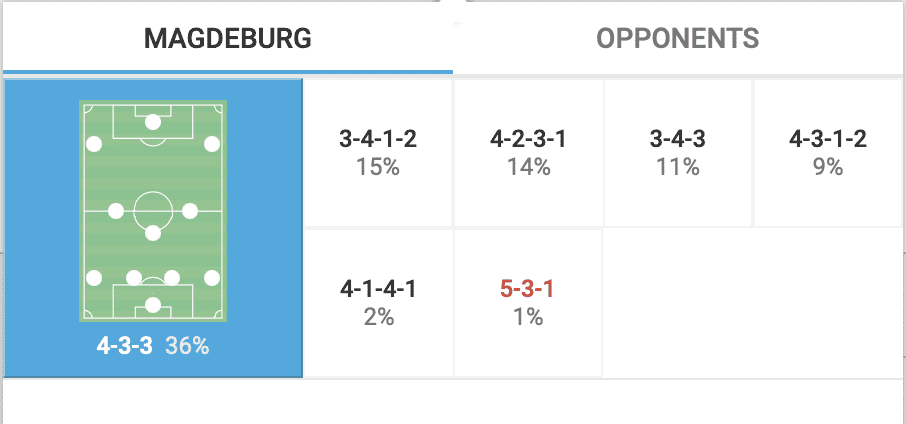
Perhaps one of the most fascinating aspects of Magdeburg’s game model is the use of their goalkeeper, Dominik Reimann, to split the CBs, forming a back three. As a result of this, Magdeburg’s full-backs virtually become wing-backs in possession, pushing up the touchline.
Daniel Elfadli and Silas Gnaka form a double pivot in the midfield, with the right winger inverting and advancing into the forward line, virtually becoming a second striker, and the left winger inverting into the midfield. The third midfielder in the 4-3-3 also advances further up the field and forms a box midfield, overloading the centre of the pitch.
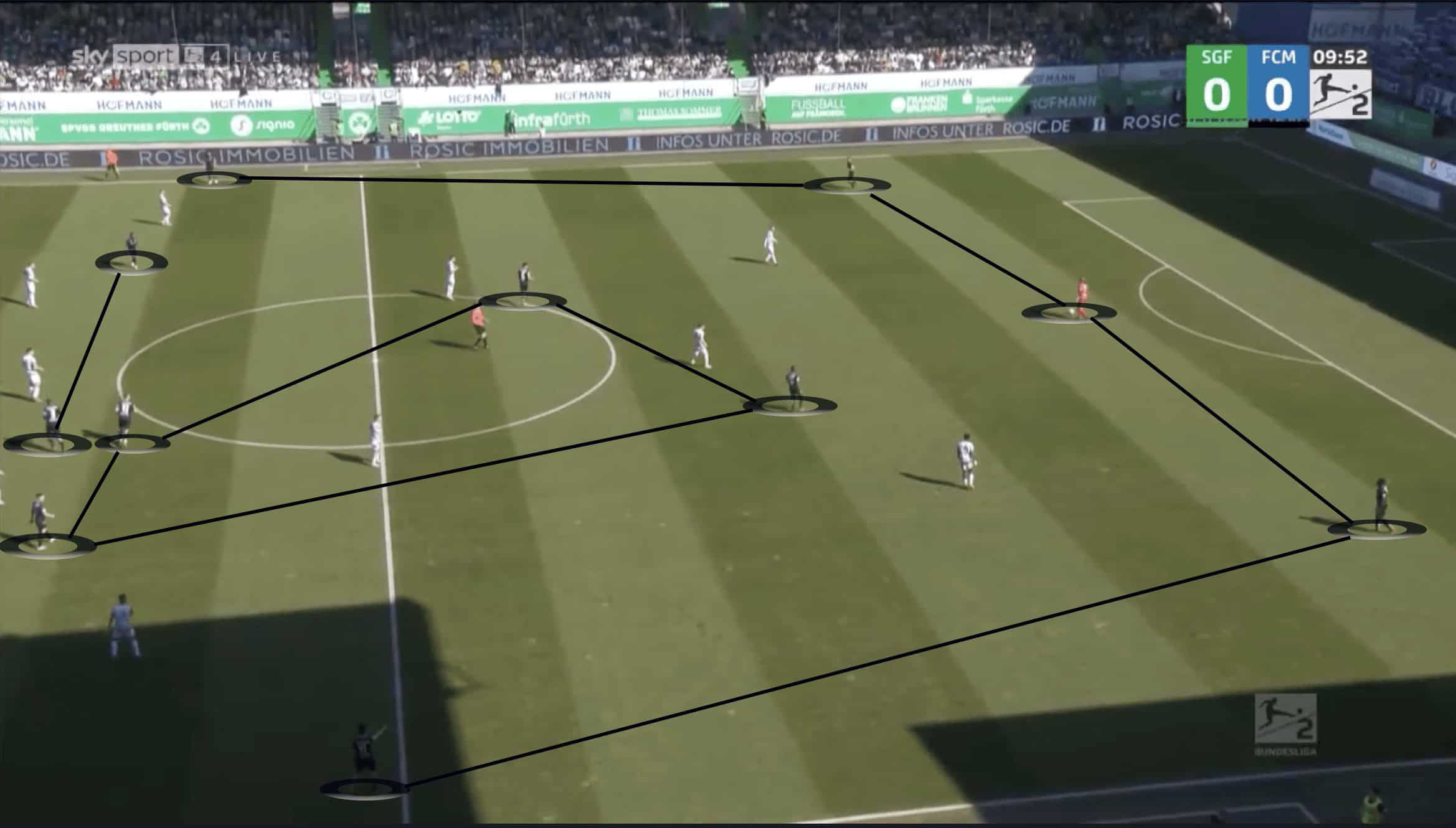
Build up play
Magdeburg look to play the ball out of the back from goal kicks, and even from as early as this point fully look to use their goalkeeper in possession to form a back three. As can be seen in the example below, after Reimann plays the ball to centre-back Jaime Lawrence, the left centre-back Daniel Herber begins to shift further out wide towards the left channel.
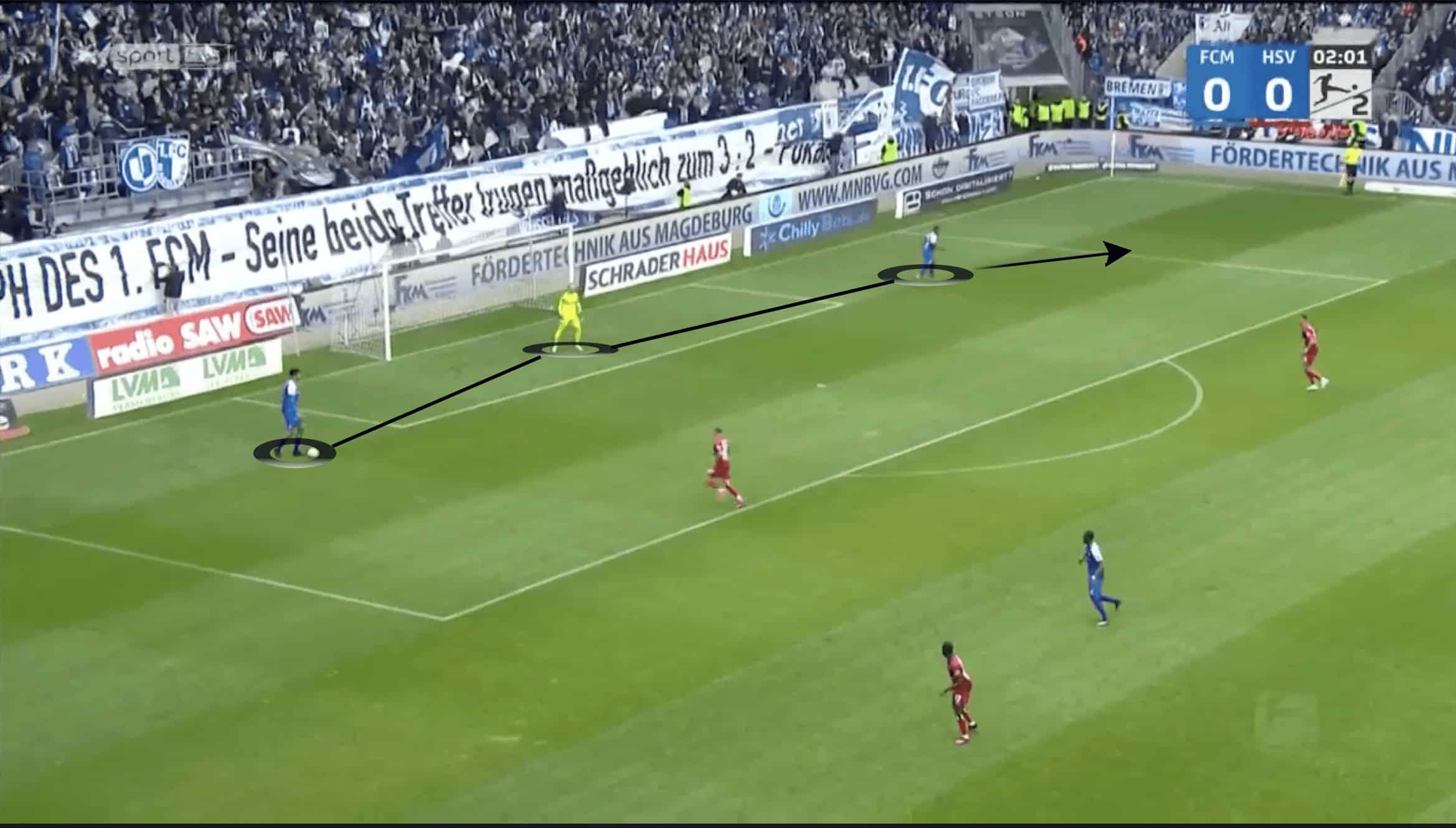
The use of the goalkeeper as a part of the defensive line yields a number of benefits. The clearest advantage is the fact that against most teams, Magdeburg will have a numerical advantage in the first line of build-up. The second is that, with the use of the goalkeeper in the defensive line, they are able to form a back three without having to use any of their other outfield players to do so. As a result, they can position more outfield players in advanced positions, aiding and enhancing their central overload.
Both in the build-up from goal kicks as well as further up the pitch, the use of a back three allows for quicker circulation at the back, allowing a quicker change in which side the team looks to attack, with Magdeburg generally choosing to progress the ball through the wide areas.
Their fullbacks in high and wide positions pin back the opposition full-backs and the positioning of other outfield players in the centre leads to the opposition positioning themselves in order to prevent Magdeburg from exploiting their numerical superiority in the centre. As a result, space is created in the channels, as seen in the example below. This gives their centre-backs the chance to dribble the ball further forward into the space ahead.
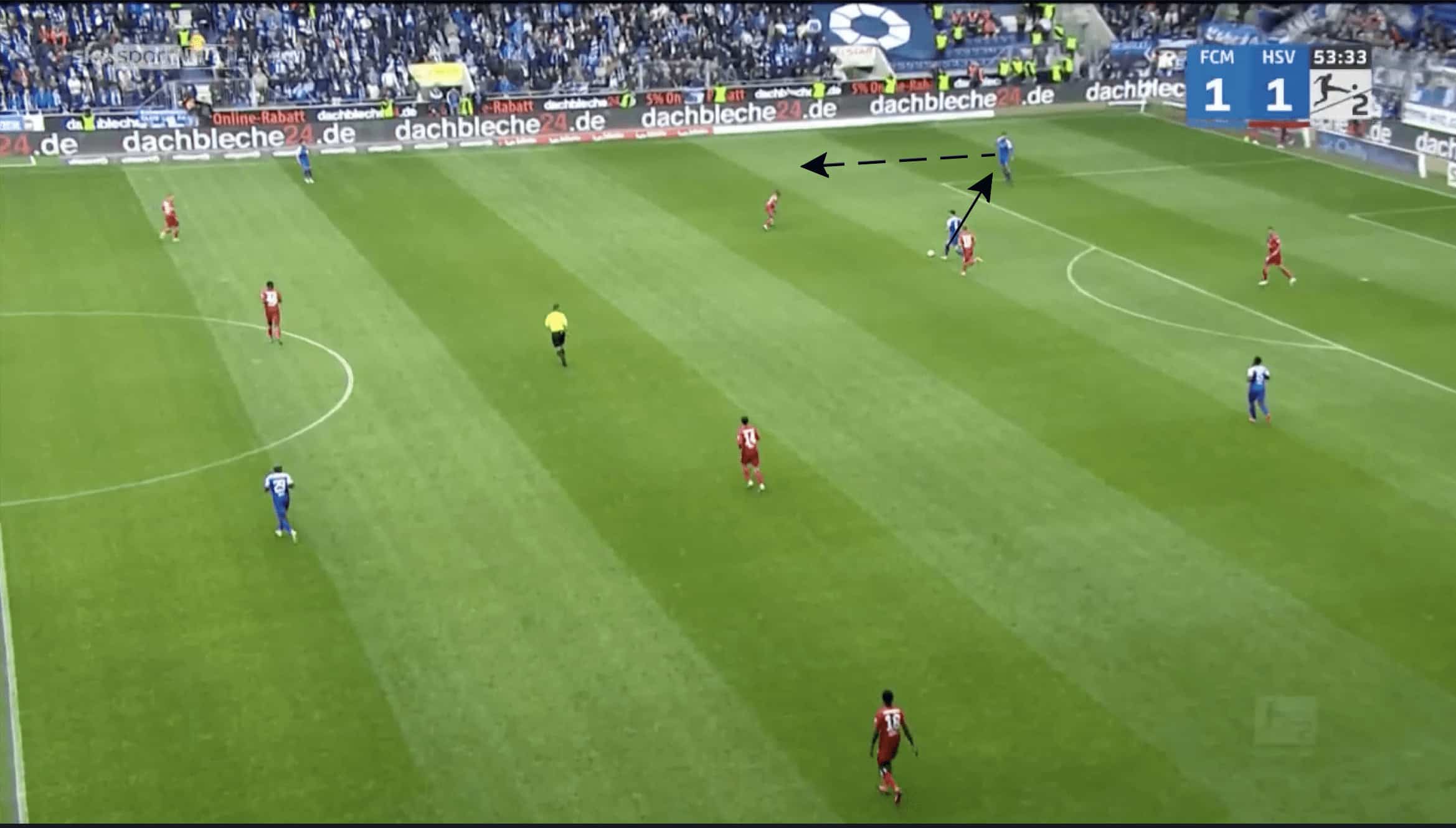
In deeper areas as well as slightly more advanced areas, at least one of the midfielders in Magdeburg’s double pivot will drop to receive the ball from the back three. If given the possibility to turn, they will look to play vertical passes to the more advanced players in the central area.
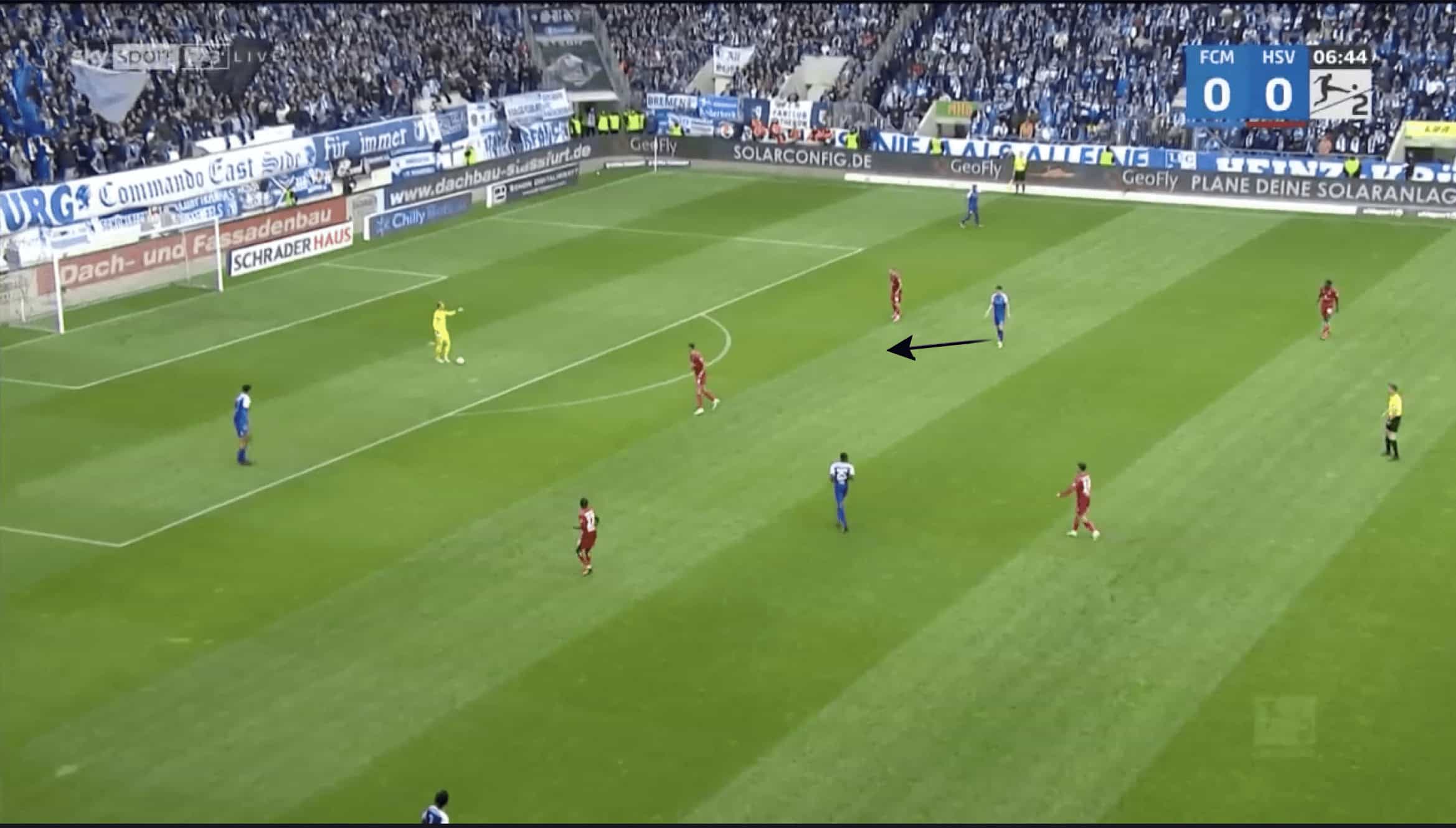
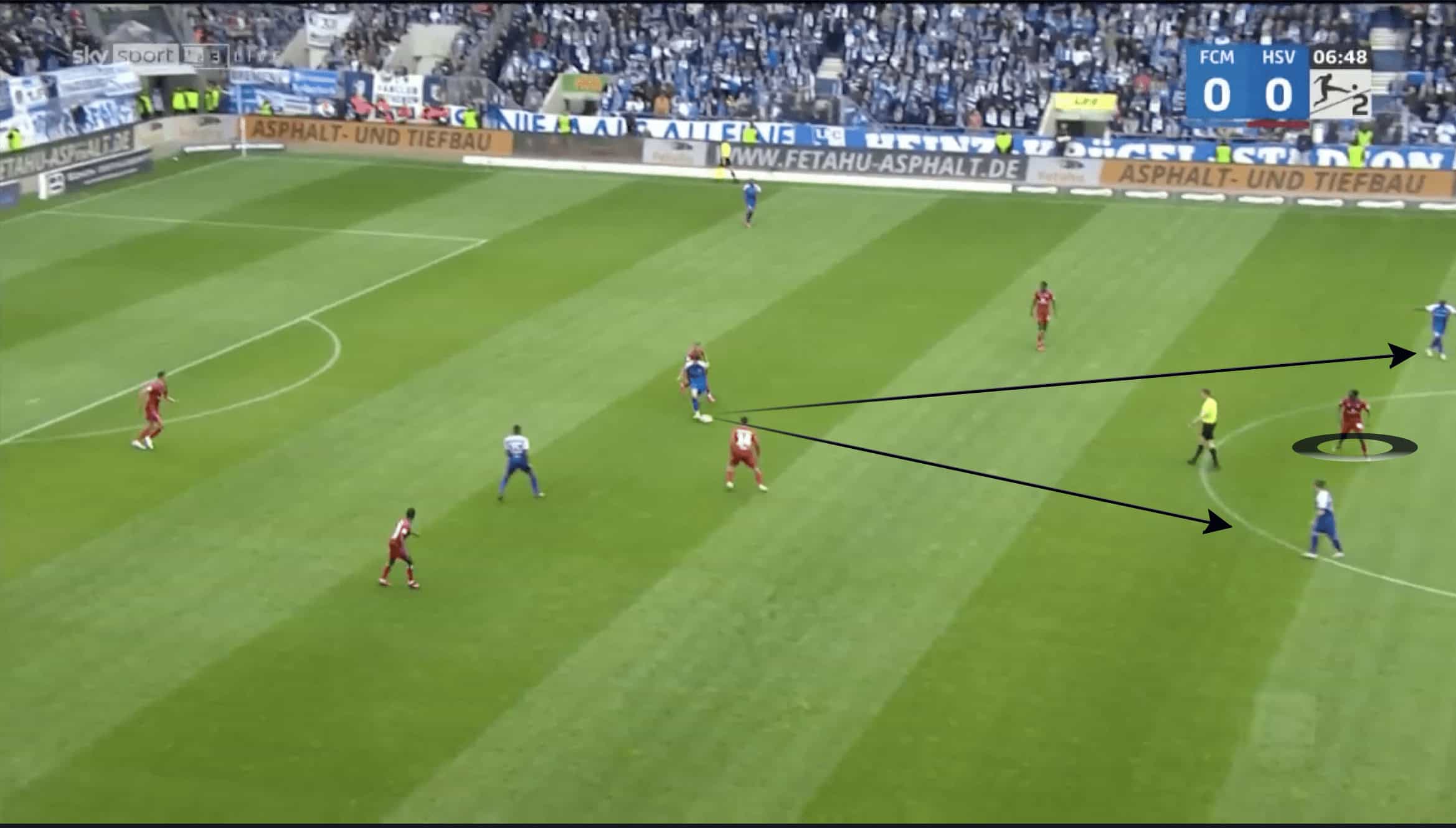
From these positions, they look to play the ball to the wide areas to take advantage of the space created in the channels.
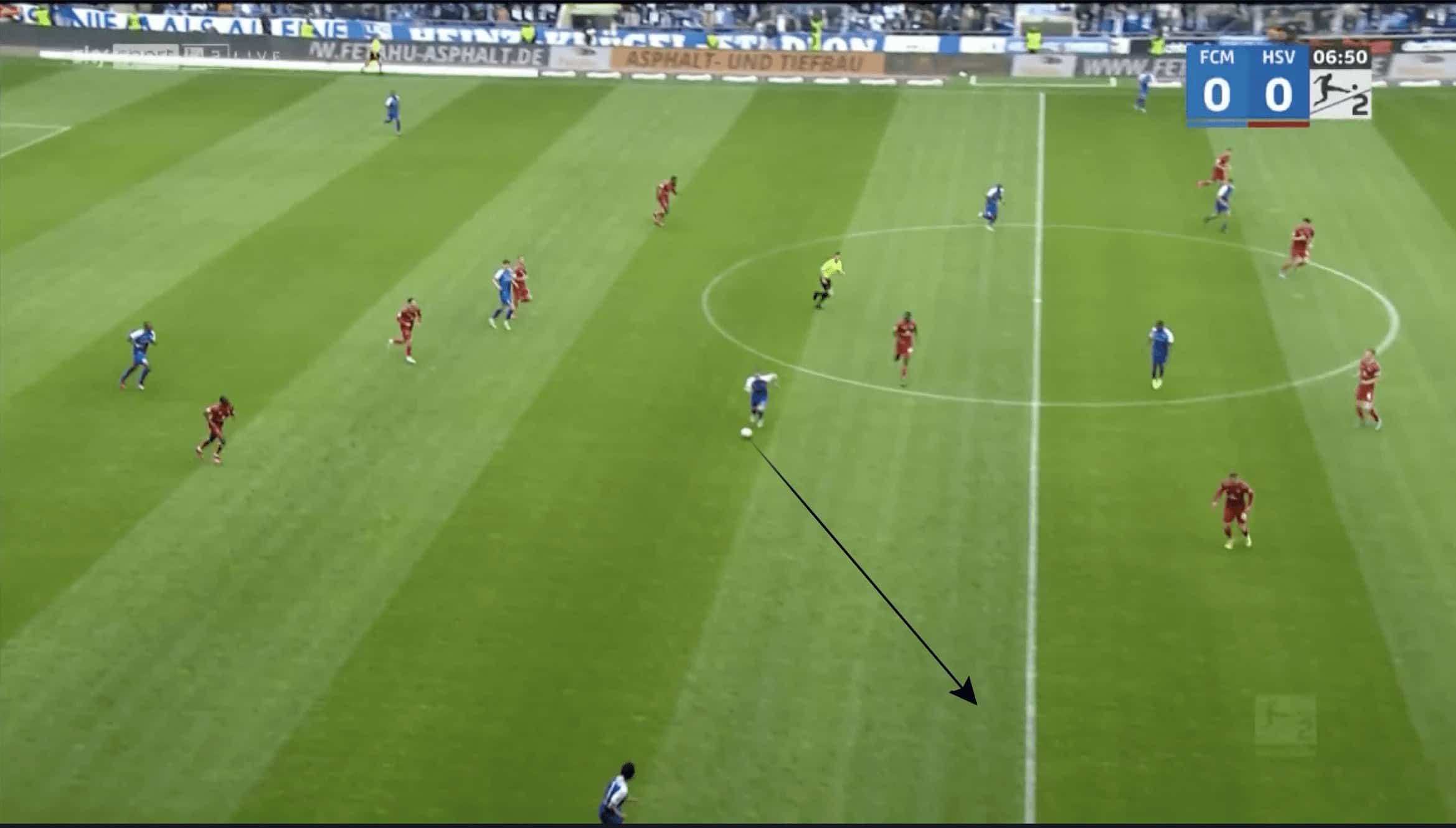
When the centre-backs have the ball, the midfielders in the double pivot may also drift wide into the channel to take advantage of the space created by the occupation of the central areas by other players and the high position of the fullbacks.
As seen in the example below, instead of dropping deep, Elfadli begins to move towards the space in the channel. This has a number of effects. The goalkeeper can either find him directly and begin the process of progressing the ball down the wing or pass to the right centre-back who can find the midfielder. Elfadli’s movement also creates space in the central areas as the opposition midfielder begins to adjust his position to the movement of Elfadli, which reduces cover in the centre, creating a vertical passing option.
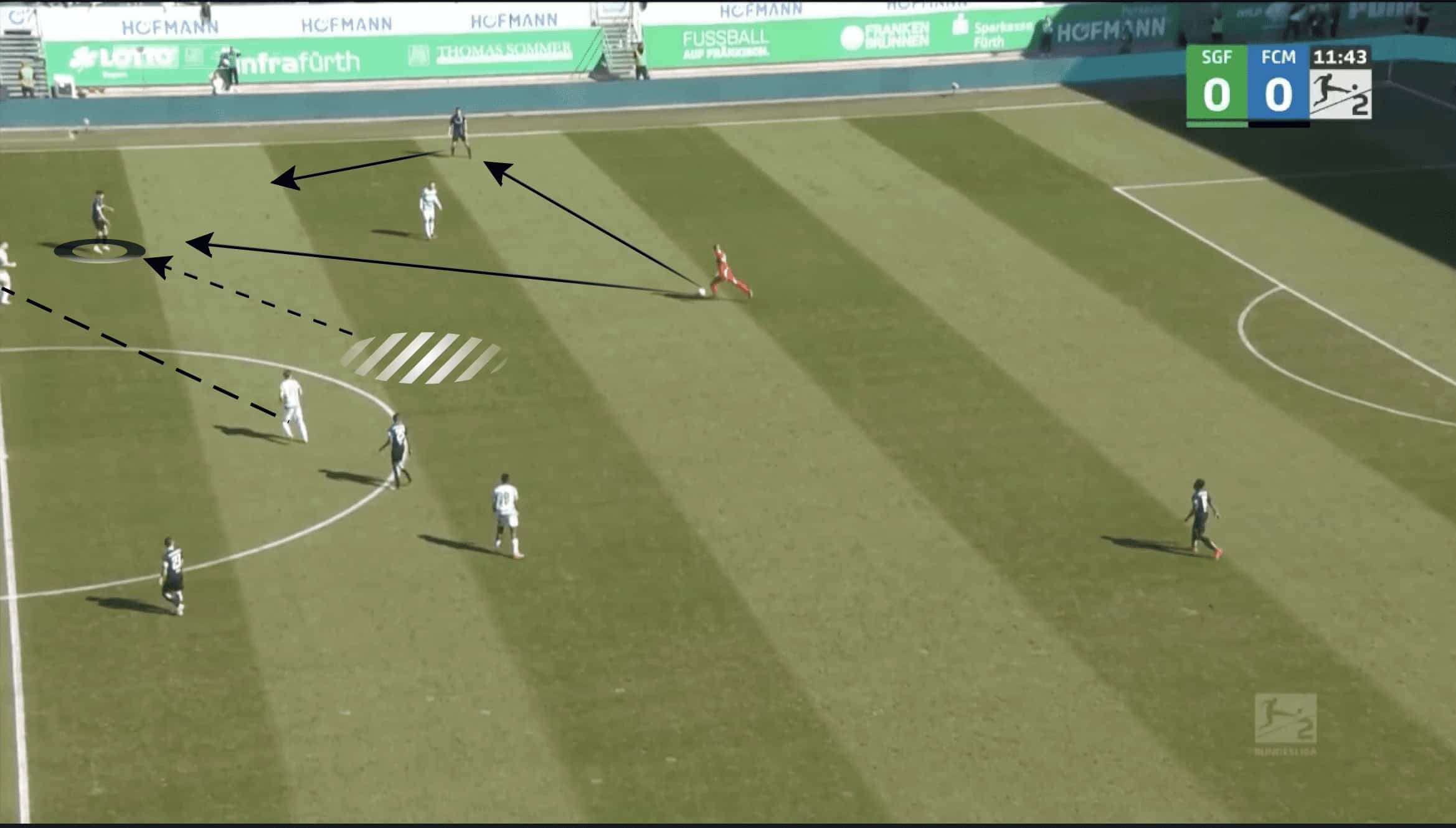
Positional rotations
Although referring to Magdeburg’s midfield structure as a “box midfield” earlier on in this analysis, it is important to note that the side are not wedded to this structure in central areas.
In certain cases, if their full-backs are in deeper areas, it is likely that their left winger and right winger will move back towards the touchline from their inverted positions as can partially be seen in the example below. Herbert Bockhorn, the former Borussia Dortmund right back, drops to a relatively deeper position. As a result of this, Jason Ceka, the right winger, moves from his inverted position in the forward line back to the touchline to provide a passing option for the full-back. This occurs on the right and left-hand side, and because of this, the two wingers will generally move between the central and wide areas, depending on the position of the full-back.
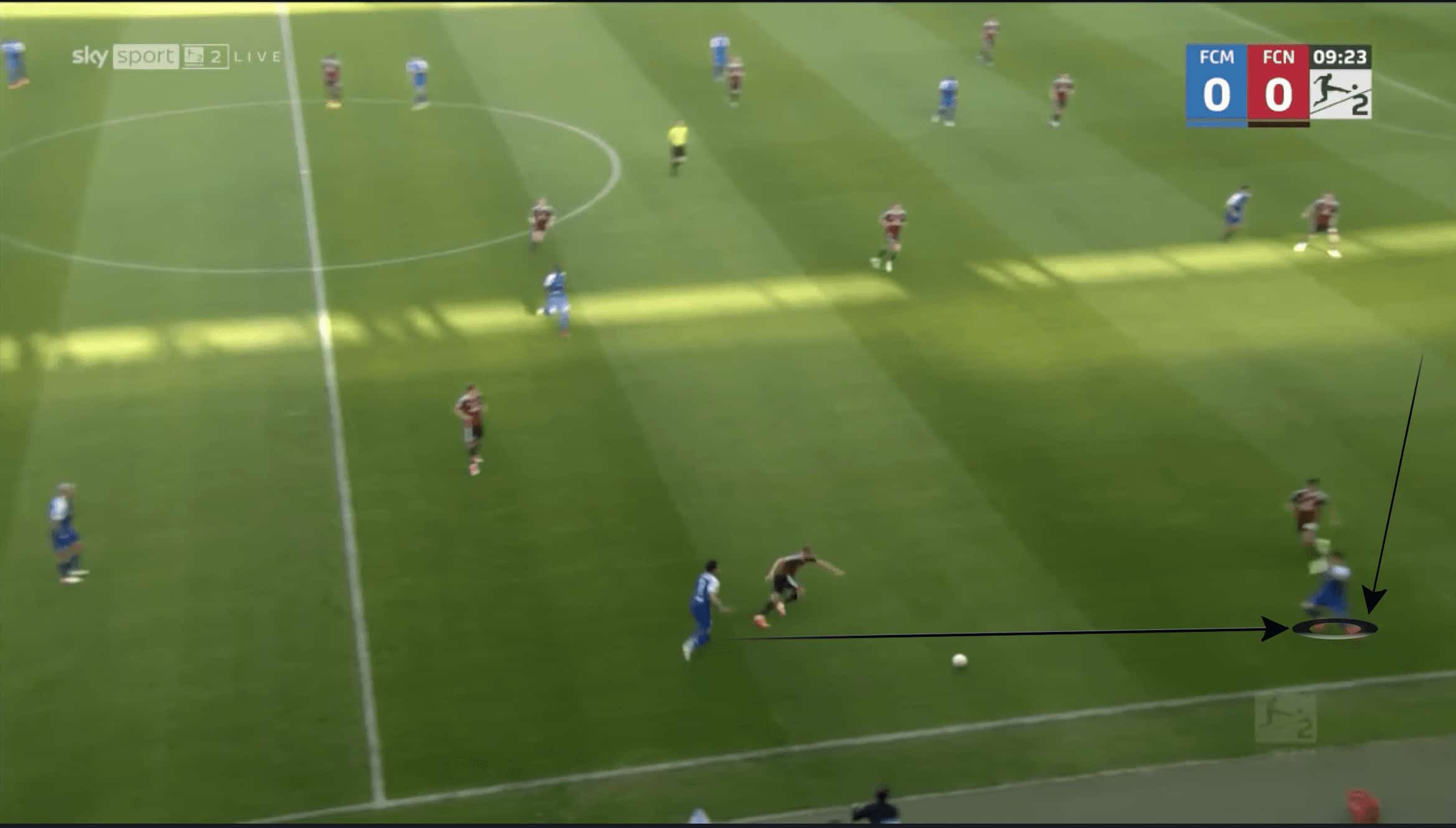
If the fullbacks are positioned in relatively deeper positions and the wingers have moved towards the wide areas, the fullbacks may also move centrally, as seen in the example below. With Mohamed El Hankouri in a deeper position, Barış Atik moves toward the touchline. El Hankouri realises this, as well as Atik’s movement into a relatively deeper position on the wing.
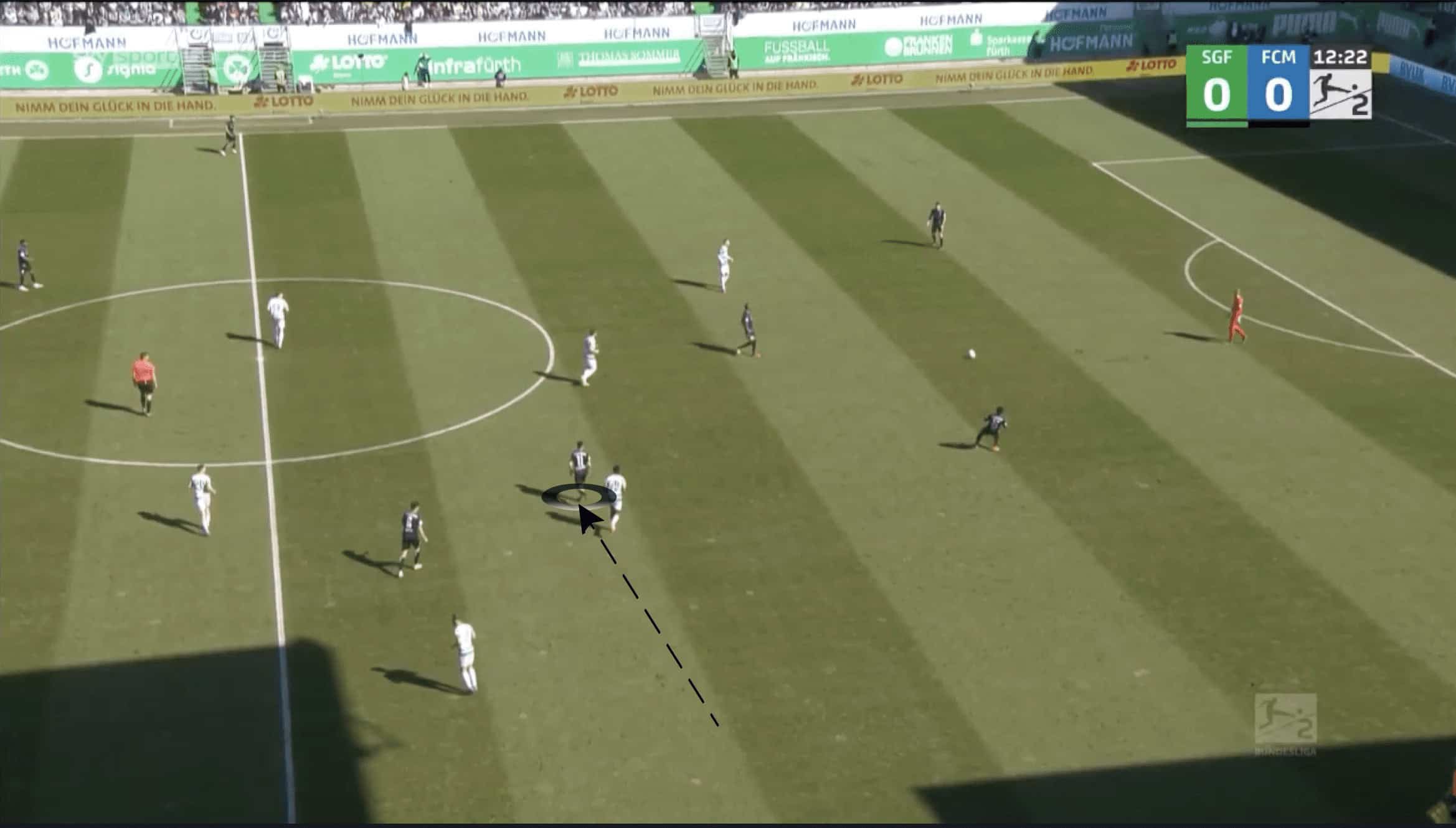
Because of this, El Hankouri moves further into the central area where he can move into a position which enables him to offer support to the goalkeeper.
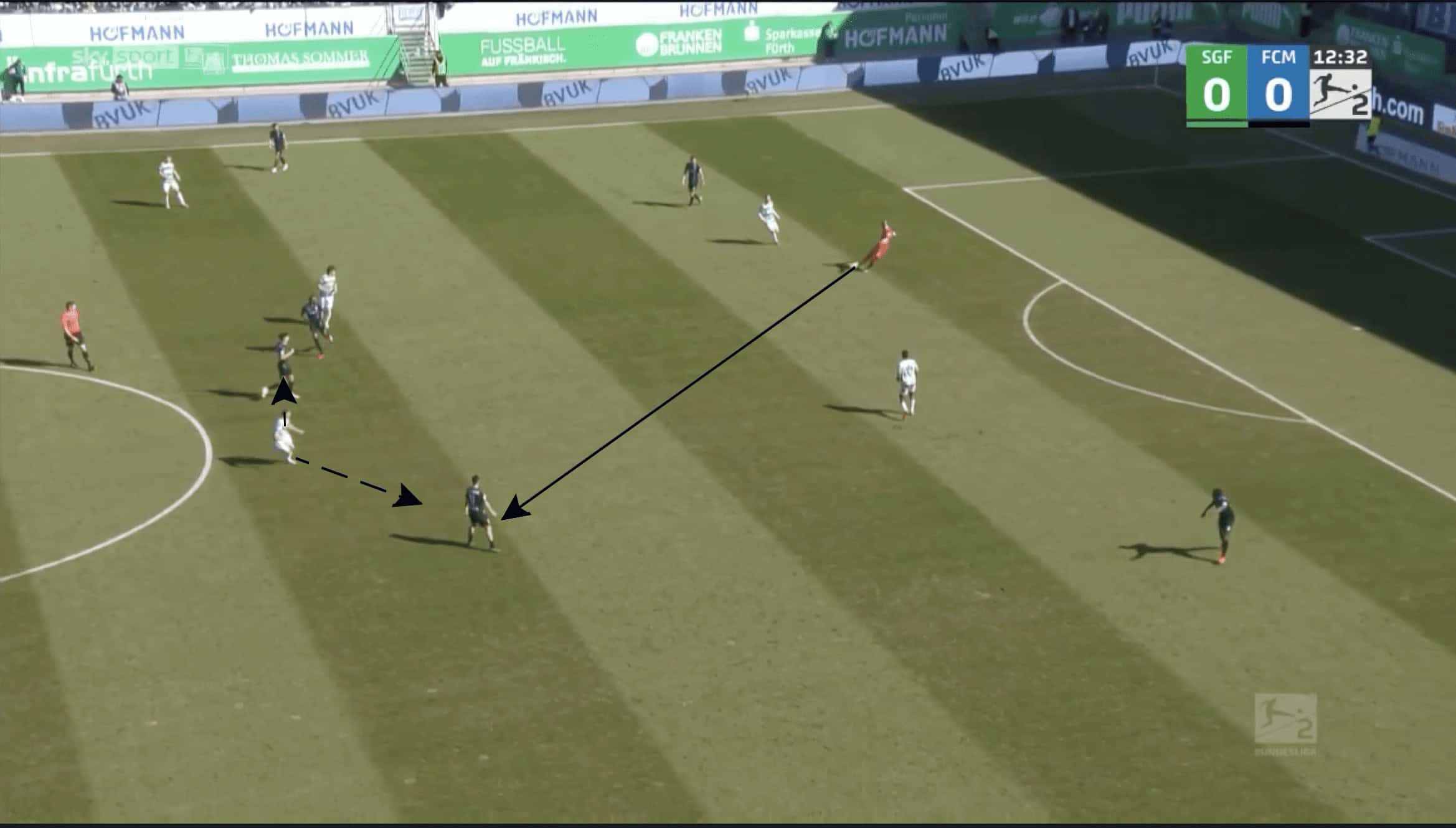
Another example of this can be seen below, with both Bockhorn as well as left-back Leon Bell Bell moving into central areas, due to the wingers moving to the touchline. And yes, his surname is Bell Bell. This wasn’t a typo in case someone comes clamouring for us on social media.
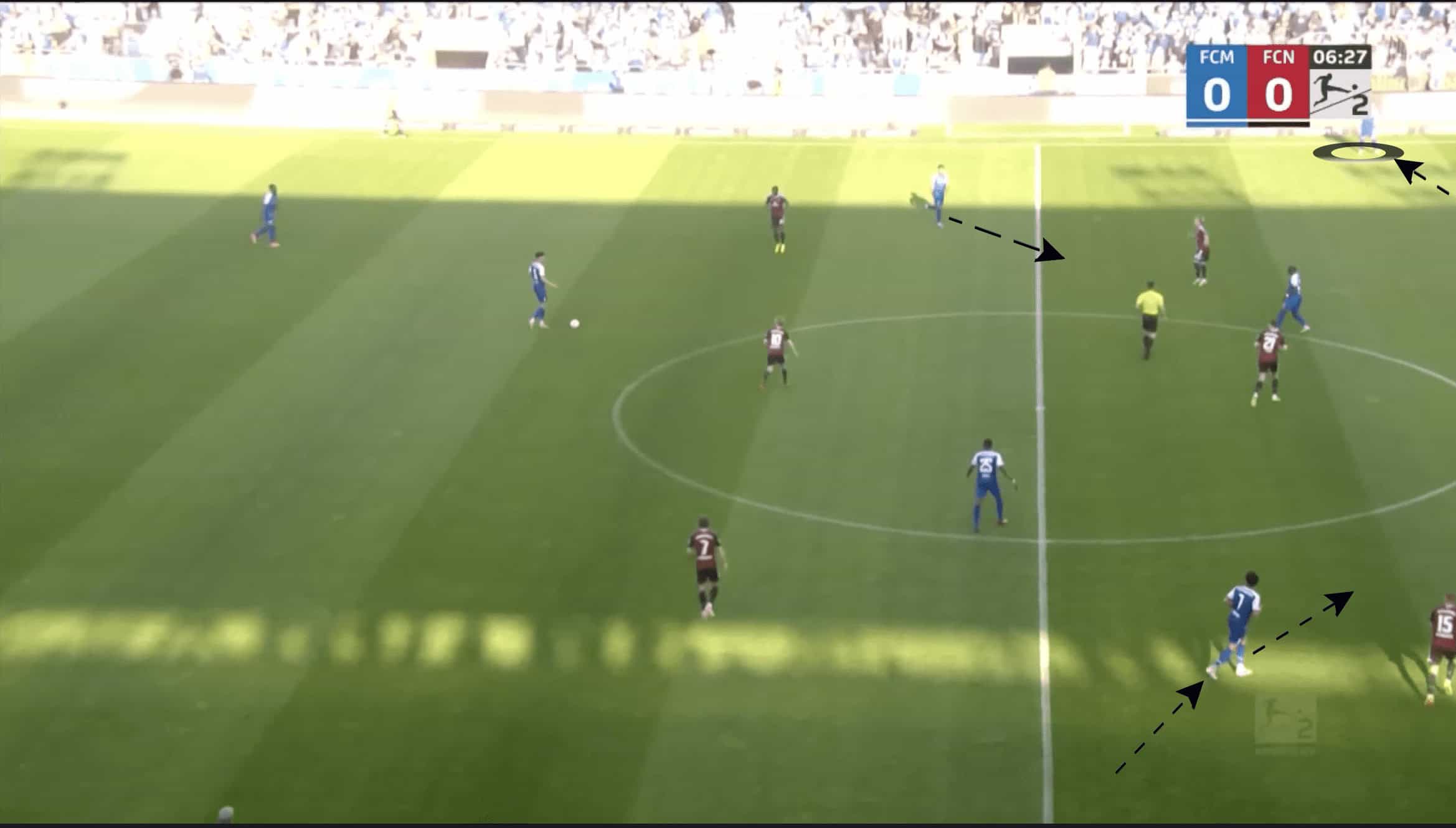
In addition to this rotation, there are also instances in which the full-backs rotate with the players in the double pivot, with this movement aiding in reducing opposition cover. This is the case as opposition players may simply follow the movements of the Magdeburg player they are marking and will not swap assignments as the players rotate.
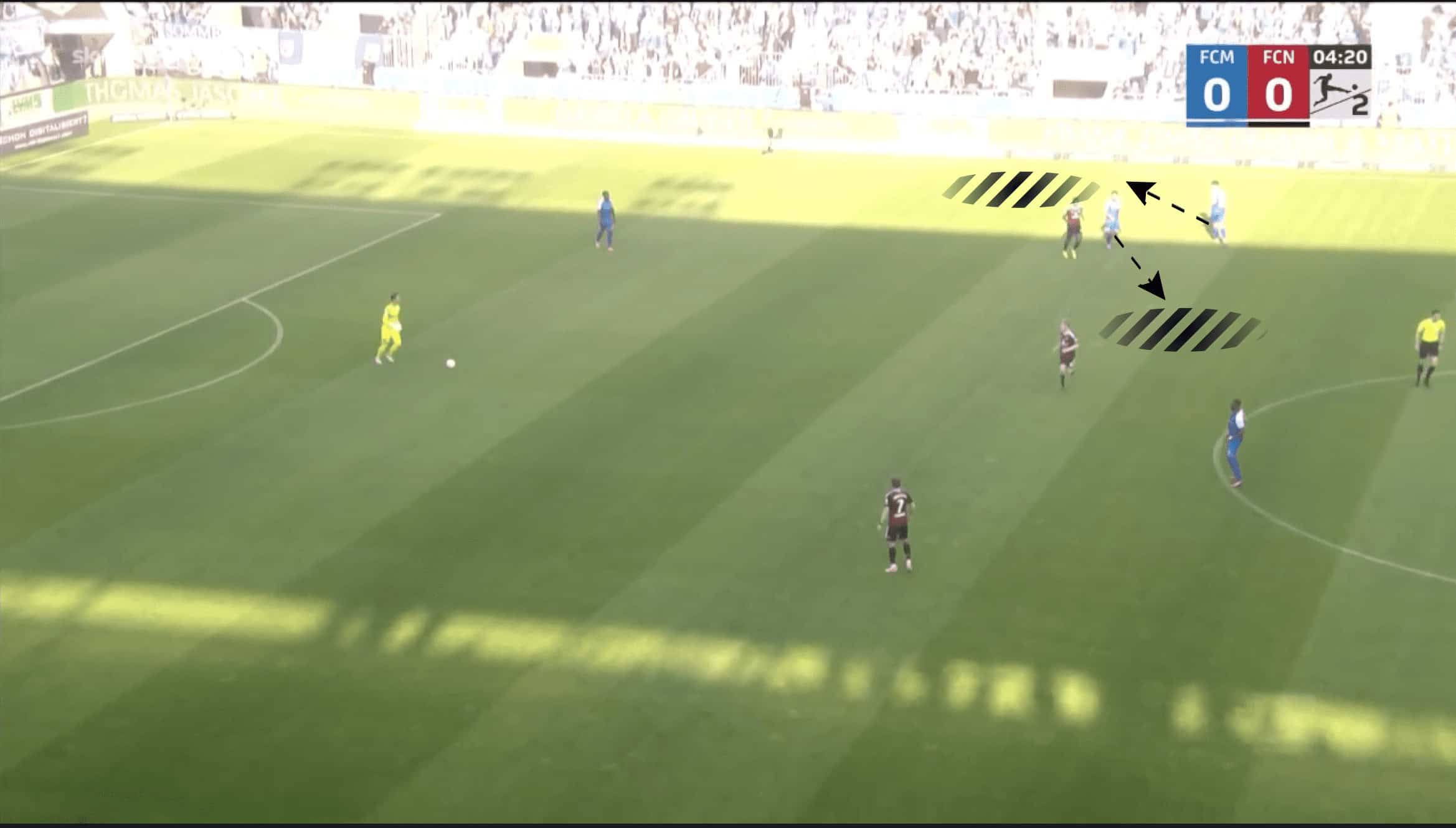
Additional methods of progression
Primarily, Magdeburg look to progress the ball in wide areas or through combinations in the centre before playing the ball out wide. In addition to this, they do not hesitate to play long balls over the top when circulating the ball at the back, looking to play the ball into the wide areas further up the pitch. This can be seen in the example below where, because of the position of their full-backs, the opposition’s full-backs primarily orient their positions towards them.
In this particular game, it reduced cover in the opposition’s last defensive line by creating space between the full-back and the centre-back, creating space for the inverted right winger to run into. Although this was the effect in this particular game, it cannot be said that this is always the intention of Magdeburg.
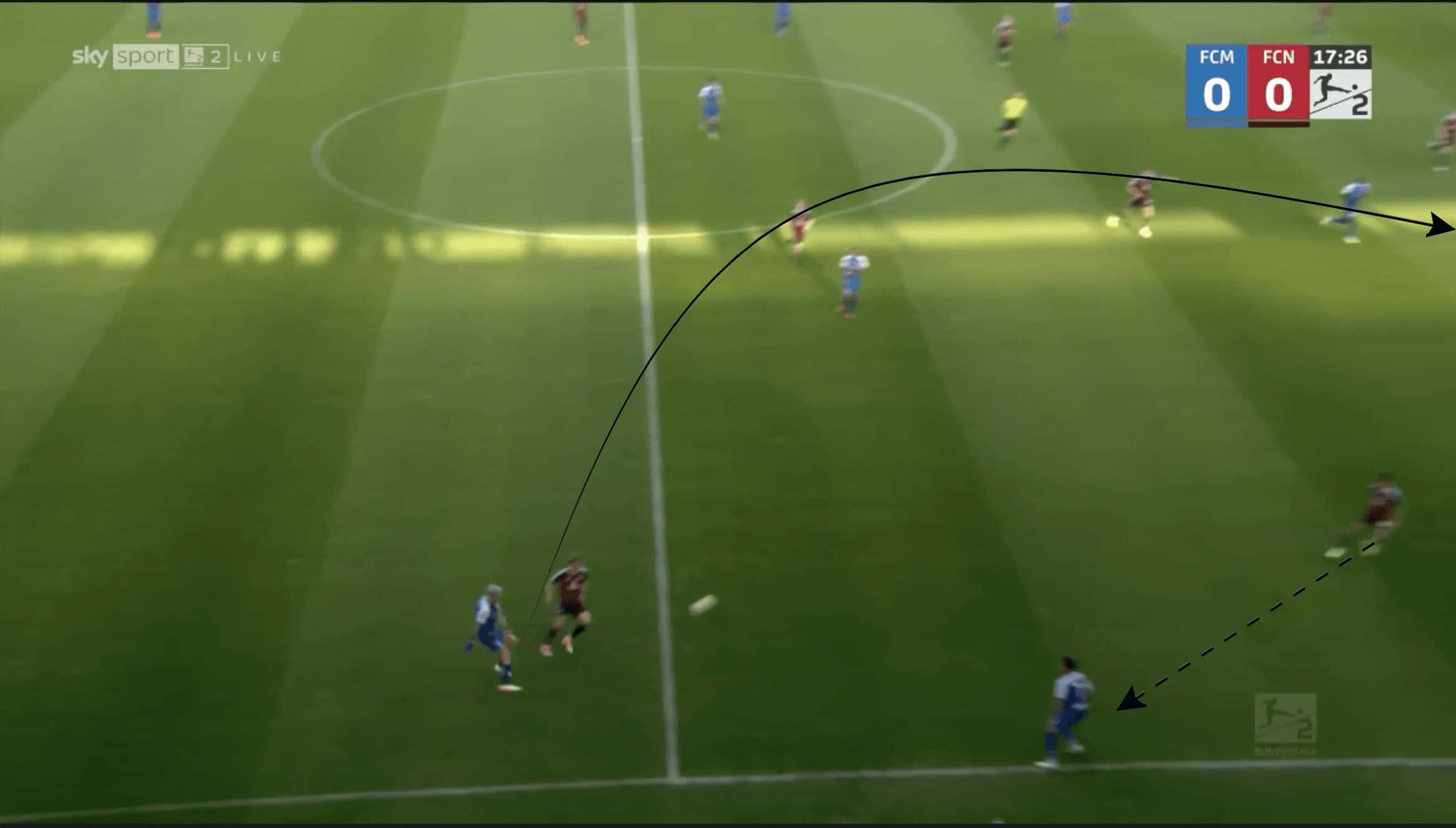
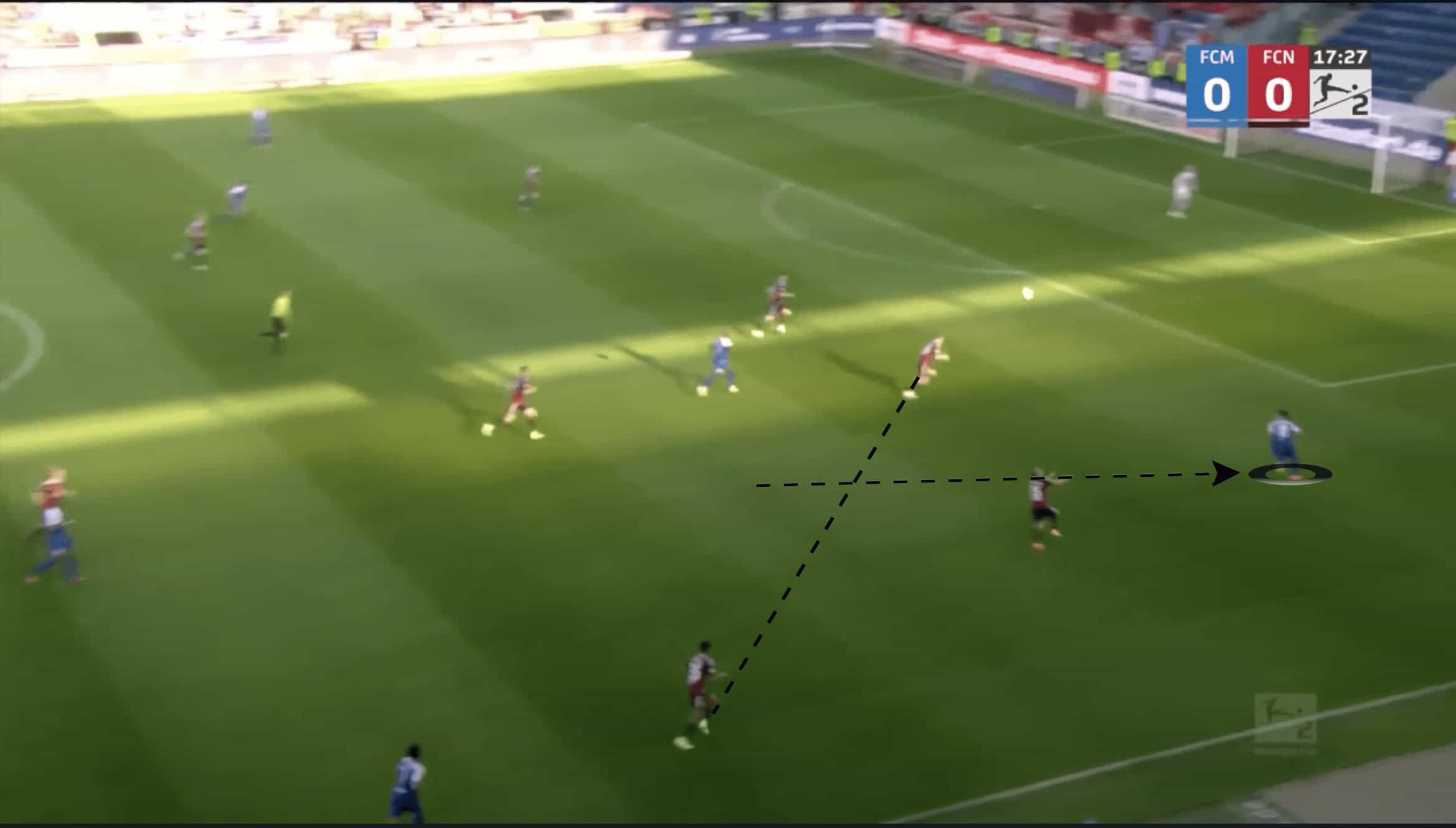
Magdeburg in the final third
Due to Magdeburg primarily looking to progress the ball through the wide areas, when the side enters the final third, rather than the majority of players making runs directly into the box, players look to make diagonal runs towards the wide area in order to support the ball carrier. In the image below, after progressing the ball through the centre and playing out wide, El Hankouri as well as Amara Conde make runs diagonally towards the ball carrier. In addition to this, Atik, the left winger, makes a diagonal run into the box and left-back Bell Bell advances to the edge of the box.
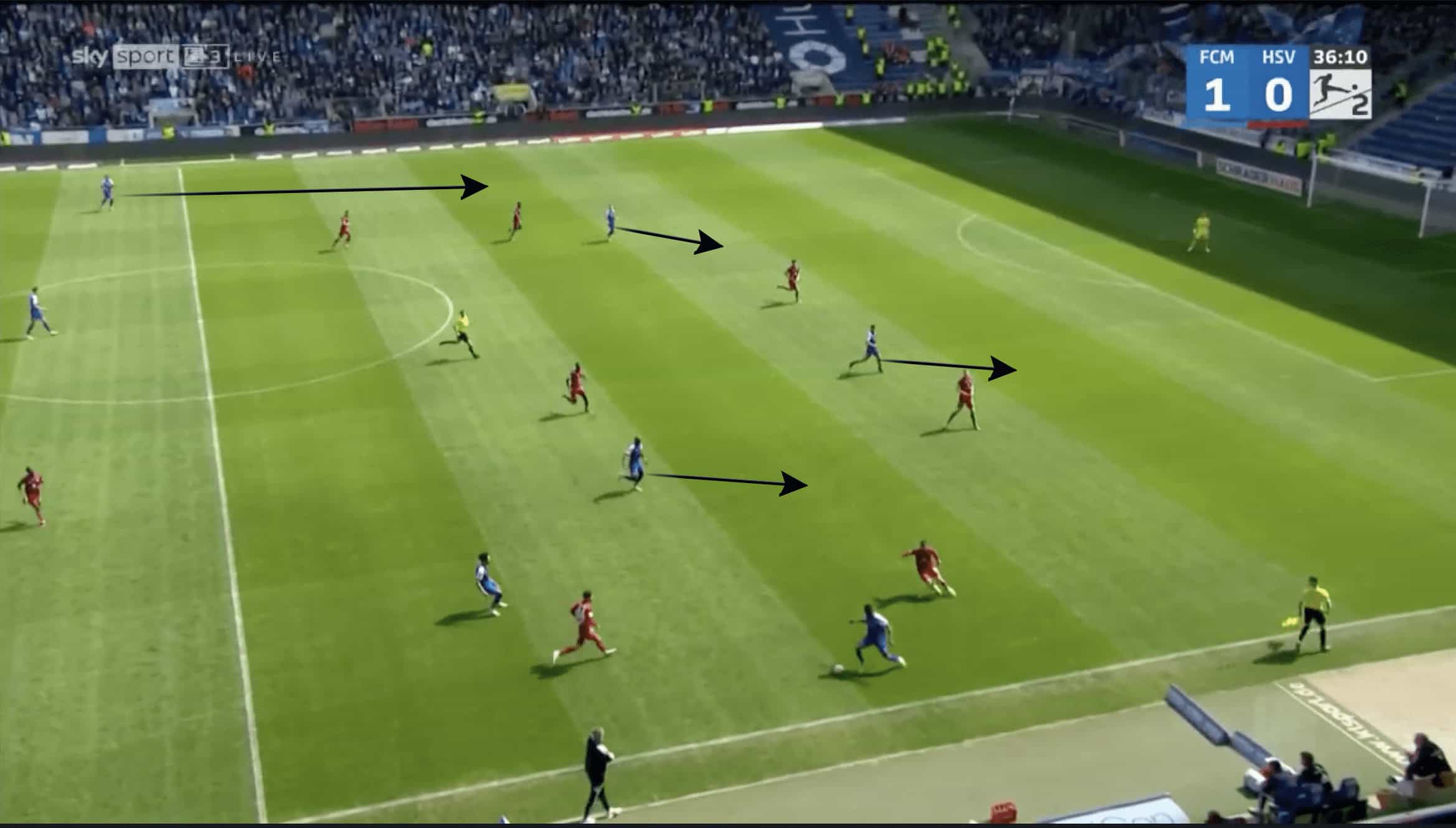
This has two effects. The first is the support provided by players to the ball carrier due to the diagonal runs of Conde and El Hankouri. This then leads to a reduction in the cover of the opposition’s last defensive line as they adjust their positions to the movements of the attackers. Magdeburg players can therefore support the player on the ball, combine with each other in the wide areas and reduce opposition cover in the last defensive line.
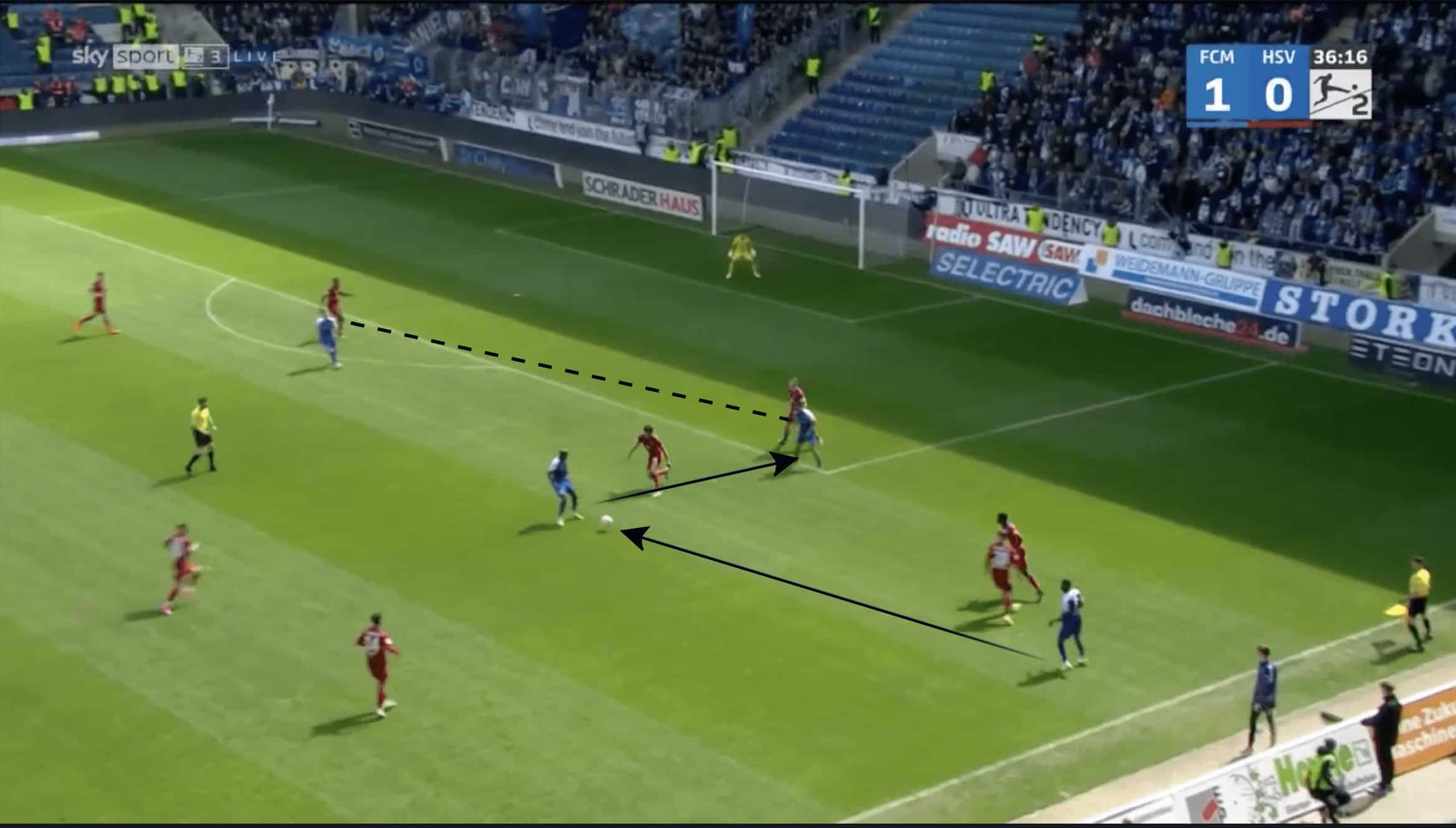
Added to this, with the position of an attacker centrally on the edge of the box, as well as the majority of attackers supporting the player out wide, space is created on the left-hand side for the advancing full-back.
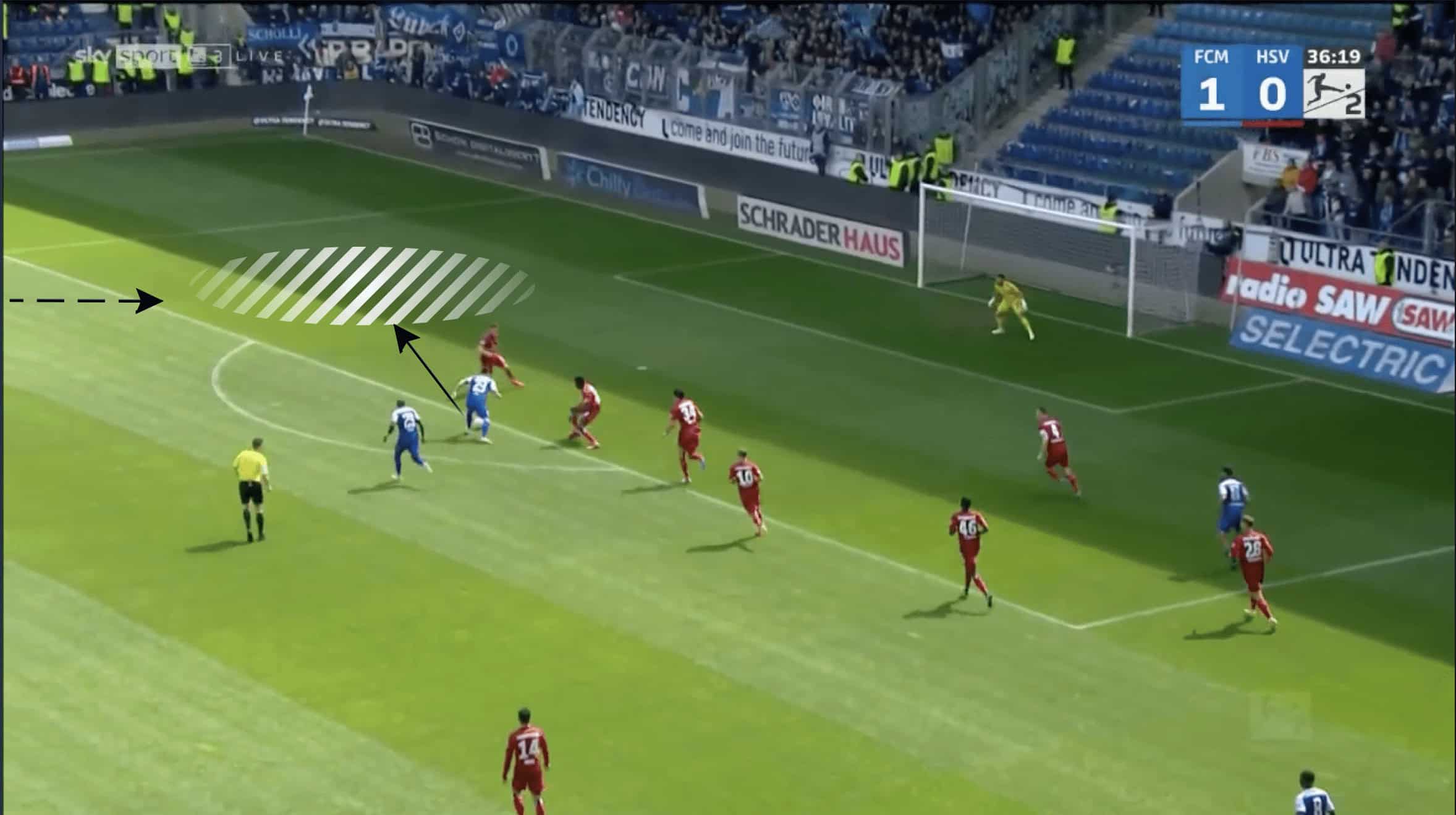
Another example of this can be seen below but this time on the left-hand side. After the ball is played wide, El Hankouri makes the same diagonal run as before and receives a pass. Bockhorn and Atik move to support him with Ceka, the left winger, now on the edge of the box, and Bockhorn also on the edge of the box but slightly wider.
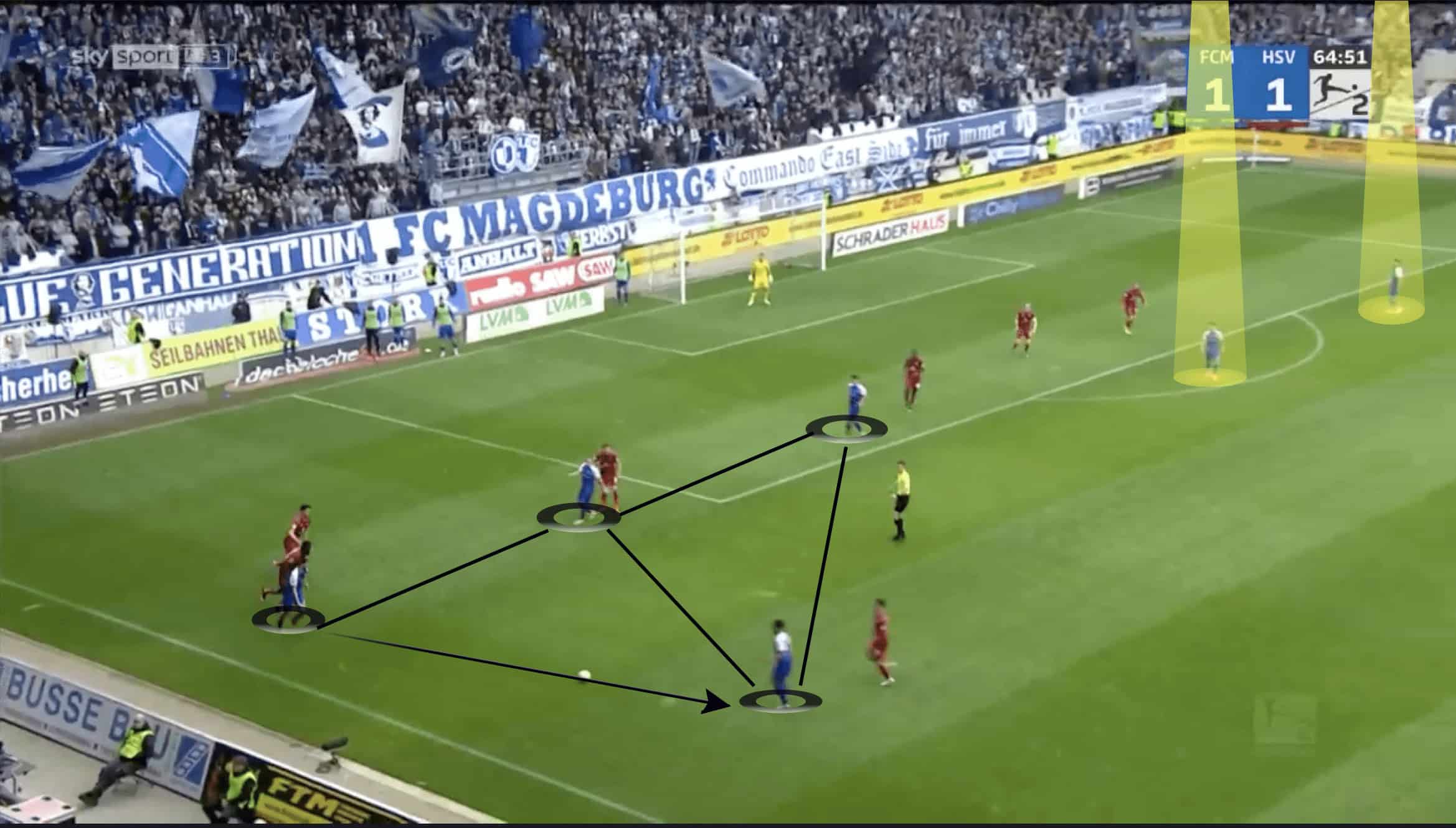
Limitations in progression
Although Magdbeurg’s movement in the final third is based on moving to support the ball carrier, at times in their own third, as well as in the midfield, this aspect of their game is lacking. This can particularly be said about the side’s double pivot. Both Gnaka and Elfadli’s actions are not necessarily in tandem with one another. As a result of this, Magdeburg are slightly easier to press in their own third and they miss many opportunities to fully take advantage of their overload in the centre.
One of the main issues can be seen in the example below. Often when receiving the ball, the two players in the double pivot do not adjust to the position of their partner. In this instance, Gnaka receives the ball with his back to goal, with the two players in the double pivot often receiving the ball in this fashion.
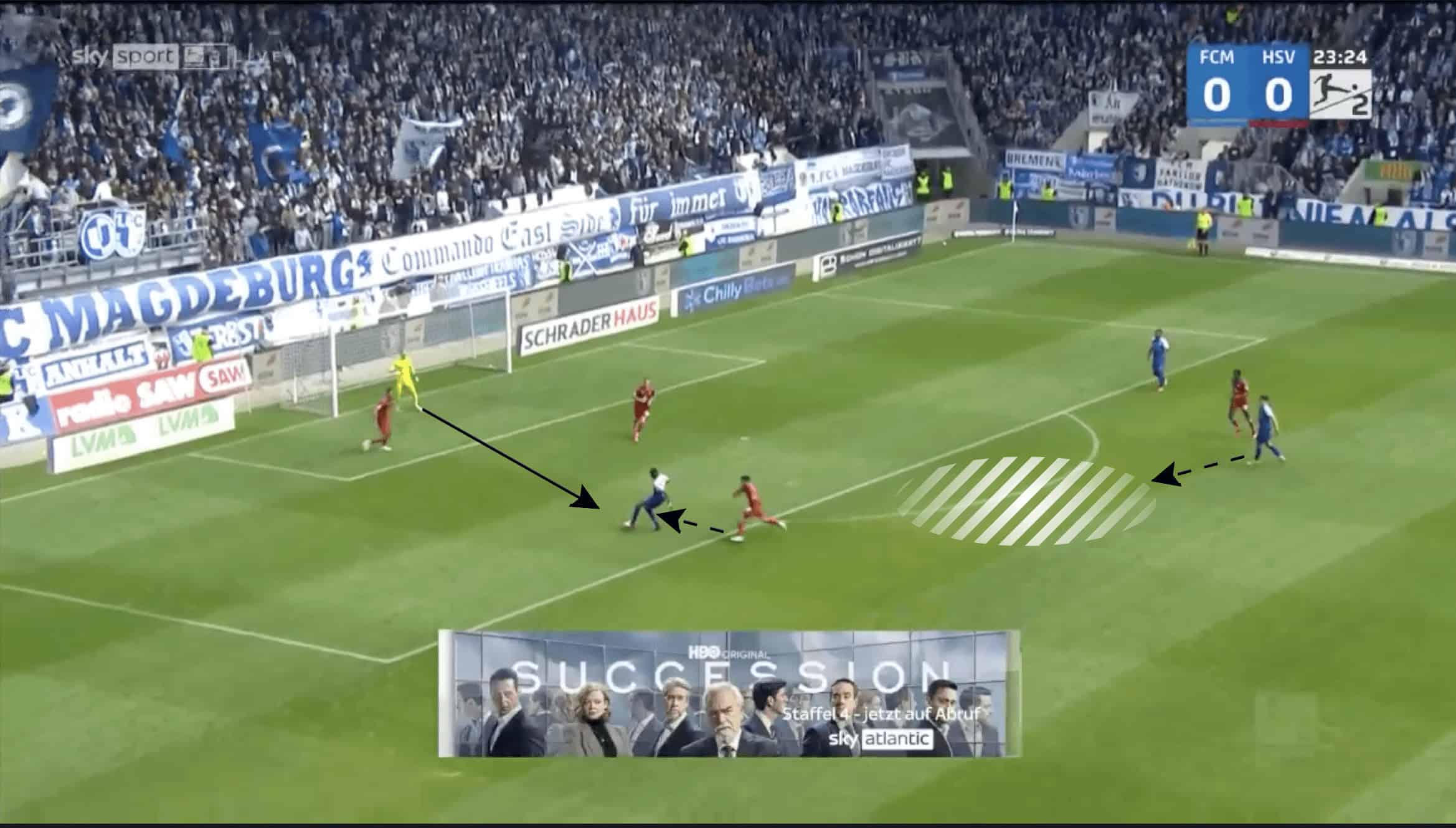
Elfadli does not adjust his position to Gnaka’s predicament by moving centrally and offering support to aid in progressing the ball. Despite the lack of support from Elfadli, Gnaka manages to play the ball forward, as can be seen in the image below. However, Elfadli, as well as Gnaka, do not provide support to Conde who receives the ball with his back to goal, ultimately losing it.
When receiving and playing vertical passes, it is imperative that the player receiving the ball has support from his teammates. Without this, not only is progression stifled, but the player receiving the ball becomes easier to press. In this instance, it would be more beneficial for the midfielders to be closer to one another, making complementary actions that can provide different angles for support, as well as moving to support the recipient of a vertical pass. This is something that Premier League side Brighton and Hove Albion’s midfielders do particularly well.
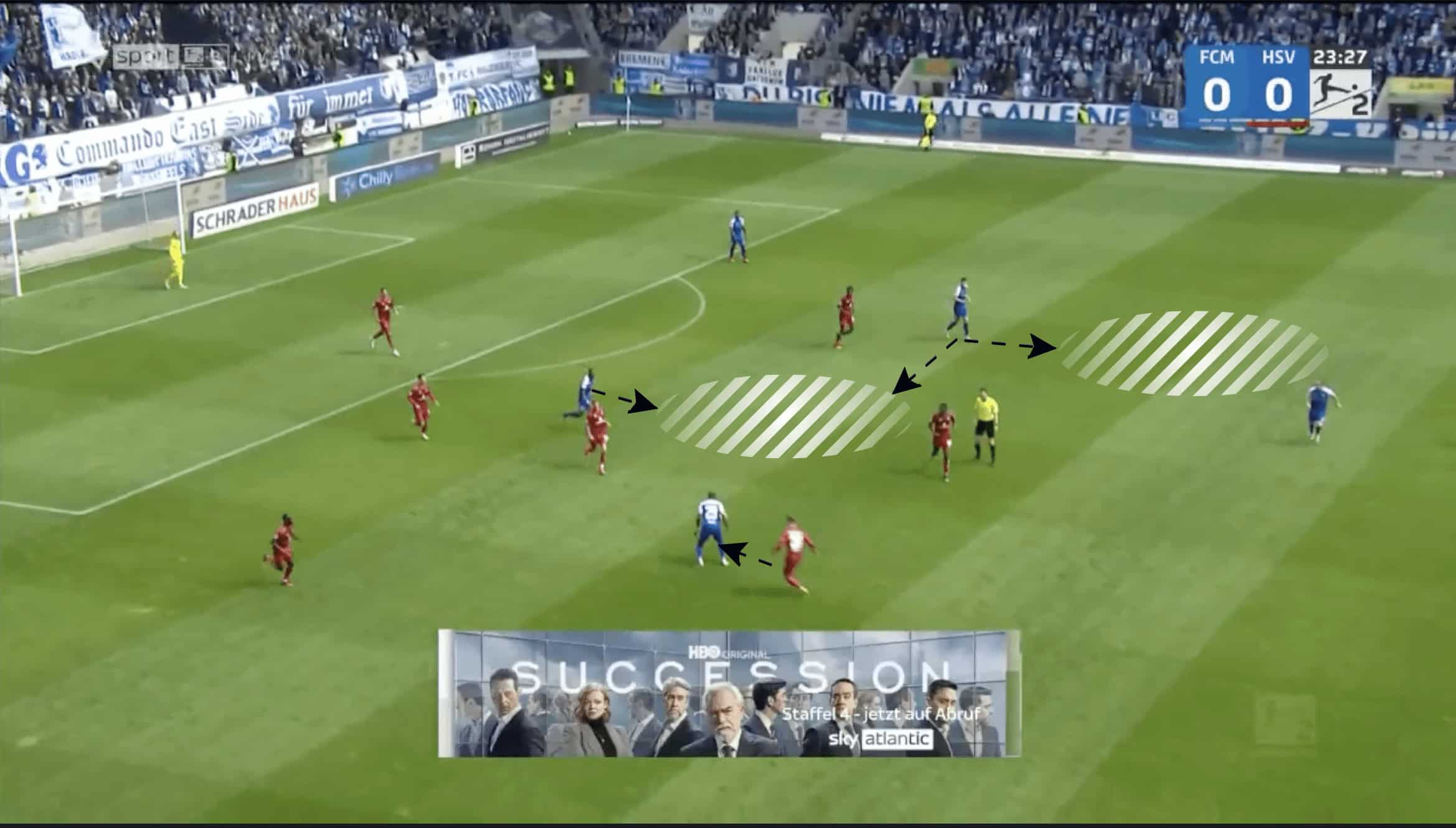
A second problem in their own third occurs due to the high positioning of Magdeburg’s full-backs. As stated earlier, Magdeburg’s full-backs are often positioned further up the pitch. As a result of this, in deeper areas, when passes are played from the centre-backs, their full-backs at times can be running into a position to receive a pass. This leads to the full-backs receiving the ball whilst running to position to receive the ball, which can be seen below. This is not necessarily negative, but the movement from the full-back is not coupled with support from players in the double pivot as well as players in more advanced areas.
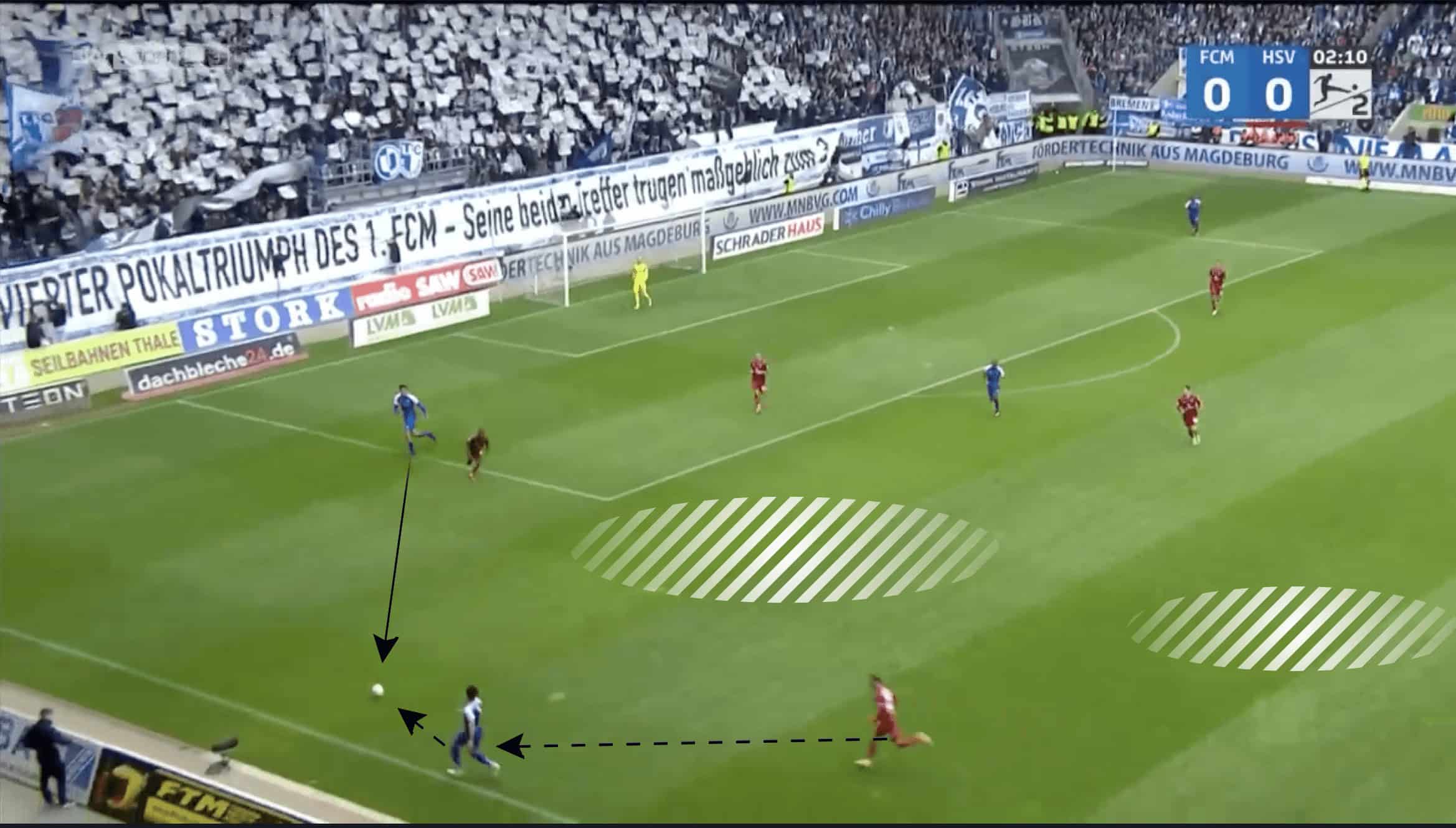
Conclusion
FC Magdeburg are a truly entertaining team to watch with interesting principles and tactics in their game model, resulting in the side taking to the 2. Bundesliga like a duck to water. Although this scout report has highlighted that they have slight issues in progressing the ball, particularly in their own third, the side does not look a world away from the top half of the league towards the Bundesliga promotion places.




Comments